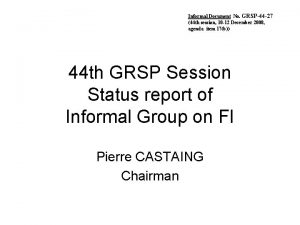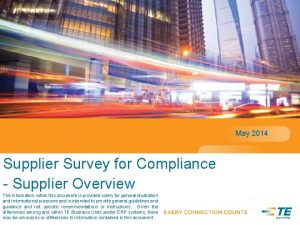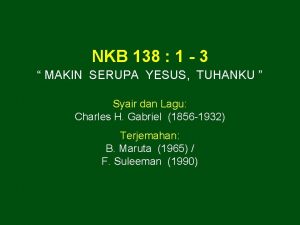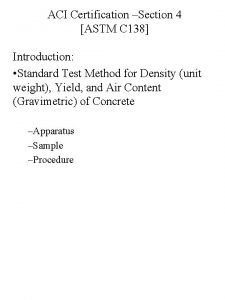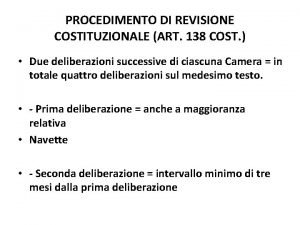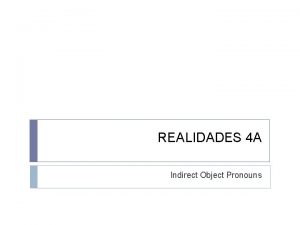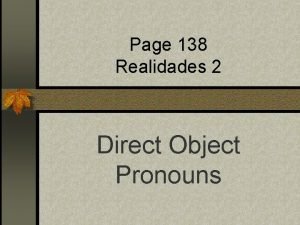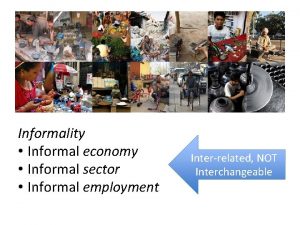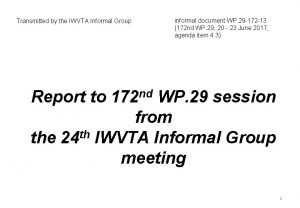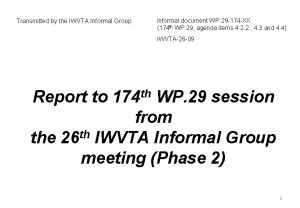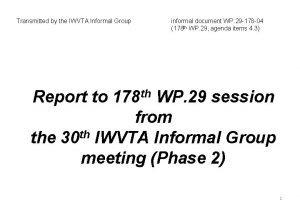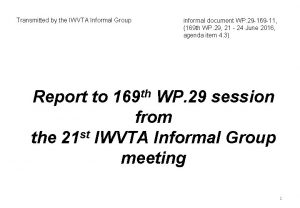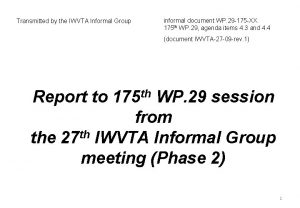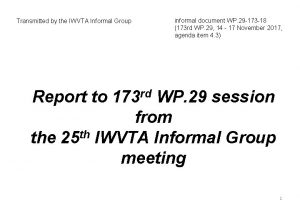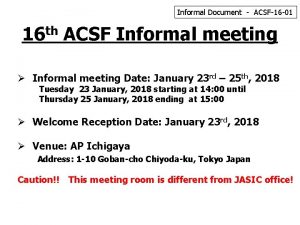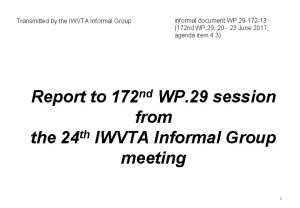Informal document No WP 29 138 20 138



















- Slides: 19

Informal document No. WP. 29 -138 -20 (138 th WP. 29, 7 -10 March 2006, agenda item 8. 4. ) United States Rulemaking on Electronic Stability Control (ESC) for Light Vehicles 138 WP. 29 March, 2006

Reason for ESC Rulemaking n n n n International consensus that ESC is effective in reducing loss-of-control crashes Evidence that it is cost effective It is practicable in terms of technical feasibility Prevention of single-vehicle crashes is the best rollover countermeasure Unlikely to become universal in small cars and pickups without a regulation Could save 1000 s of lives a year Congressional pressure if we fail to be proactive

Cost Effectiveness Evaluation n General approach • Evaluated fatal single vehicles crashes from 1997 thru 2003 • Compared specific make/models with ESC with earlier versions without ESC n Results • NHTSA found that fatal single vehicle crashes were reduces by: – 30 percent for passenger cars – 63 percent for SUVs • Results were statistically significant n A second updated study was recently completed with similar results

Timeline n n n NPRM to OST- January 2006 NPRM to OMB – 2 nd quarter 2006 NPRM publish date – Expected late summer 2006

New Standard Would Consist of: A test procedure that new vehicle would have to pass 1. • Test designed to prevent transient oversteer An equipment standard requiring vehicles to have ESC 2. • Will encourage: – Excessive understeer mitigation – Intervention to slow vehicle in emergency situations Requirements for ESC driver interface 3. • • • ESC malfunction indication lamp ESC activation warning Other interface issues

Performance Test

Performance Test: n Sine with dwell maneuver • Lightly loaded vehicle with, for LTV, outriggers • Steering frequency fixed at 0. 7 Hz, with a 500 ms pause • Steering robot • 80 kph entrance speed • Dropped throttle • Dry asphalt pavement

Performance Test: n Sine with dwell - Justification: • Most severe maneuver found for inducing spinout • Very good repeatability • Straightforward to perform – Many companies have performed without difficulty • Good face validity – Approximates obstacle avoidance maneuver

Pass/Fail Criteria: Two sets of pass/fail criteria: 1. Must not spinout (no loss of control or lateral stability) during test 2. Must have adequate lateral responsiveness

ESC Equipment Requirement

ESC Equipment Requirement: n n Would require vehicles to have ESC Multiple definitions for ESC have been proposed: • • General Motors Germany’s VDA SAE J 2564 NHTSA analyzed these and others to come up with a definition

Requirements for ESC Driver Interface

Advanced Safety Systems Malfunction Indicator: n Vehicles have more and more advanced safety systems: • Common now: – Antilock Brake Systems – Tire Pressure Monitoring Systems – Traction Control Systems – Electronic Stability Control – Brake Assist • May be coming soon: – Adaptive Cruise Control with Braking Authority – Active Steering – Electronic Damping Control – Others

Advanced Safety Systems Malfunction Indicator: n n If there is a malfunction telltale for each system, it can quickly become confusing Many of these systems use common components • Electronic control unit • Wheel speed sensors n If one system malfunctions, others are likely to also be out-of-service

Advanced Safety Systems Malfunction Indicator: n Considered having one telltale that would indicate malfunctions for multiple systems • Systems using common light must be important but not critical (i. e. , they must have a yellow malfunction light) – Could not use this light for brake system failure • Could limit use to systems that involve traction (ABS, Brake Assist, Traction Control, ESC) or could be more general and allow use for TPMS, Adaptive Cruise Control with Braking Authority, Electronic Damping Control, etc.

ESC Activation Warning: n n A single standardized icon is recommended Results of large Industry study of ESC icon comprehension was used to reach decision

ESC Activation Warning: ESC activation warnings - should they be optional or mandatory? • Does not appear to help during the critical situation for which warning activates • Activation warnings that persist for a few seconds after critical event may be more visible to drivers • May have beneficial effects on longer-term driver performance

Other Interface Issues: n Should driver disabling of ESC be permitted? • Needed to prevent vehicle from getting stuck in deep snow, driving with snow chains, and off-roading n Should optional ESC modes be allowed? • Desirable for racing/sports car enthusiasts n Should the ESC reset to standard mode every time ignition is cycled • Manufacturer may want to reset ESC under other, suitable conditions

Thank You For more info go to: http: //dms. dot. gov/ NHTSA Docket Number 19951
 Document
Document Informal document
Informal document Ejemplos de lenguaje formal e informal
Ejemplos de lenguaje formal e informal Tec-138-702
Tec-138-702 Makin serupa yesus tuhanku
Makin serupa yesus tuhanku 109+138
109+138 Astm 138
Astm 138 Art 138 cost
Art 138 cost Pg 138
Pg 138 Hbu115
Hbu115 Ps 138
Ps 138 Psalms 138:1-3
Psalms 138:1-3 Iambic trochaic
Iambic trochaic Salmo
Salmo Direct object pronouns (p. 138) answers
Direct object pronouns (p. 138) answers Capitulo 4a indirect object pronouns continued
Capitulo 4a indirect object pronouns continued Direct object pronoun for la mochila
Direct object pronoun for la mochila Aasb 138 intangible assets
Aasb 138 intangible assets Tiempo de orar salmo 138
Tiempo de orar salmo 138 Direct object pronouns p.138
Direct object pronouns p.138

